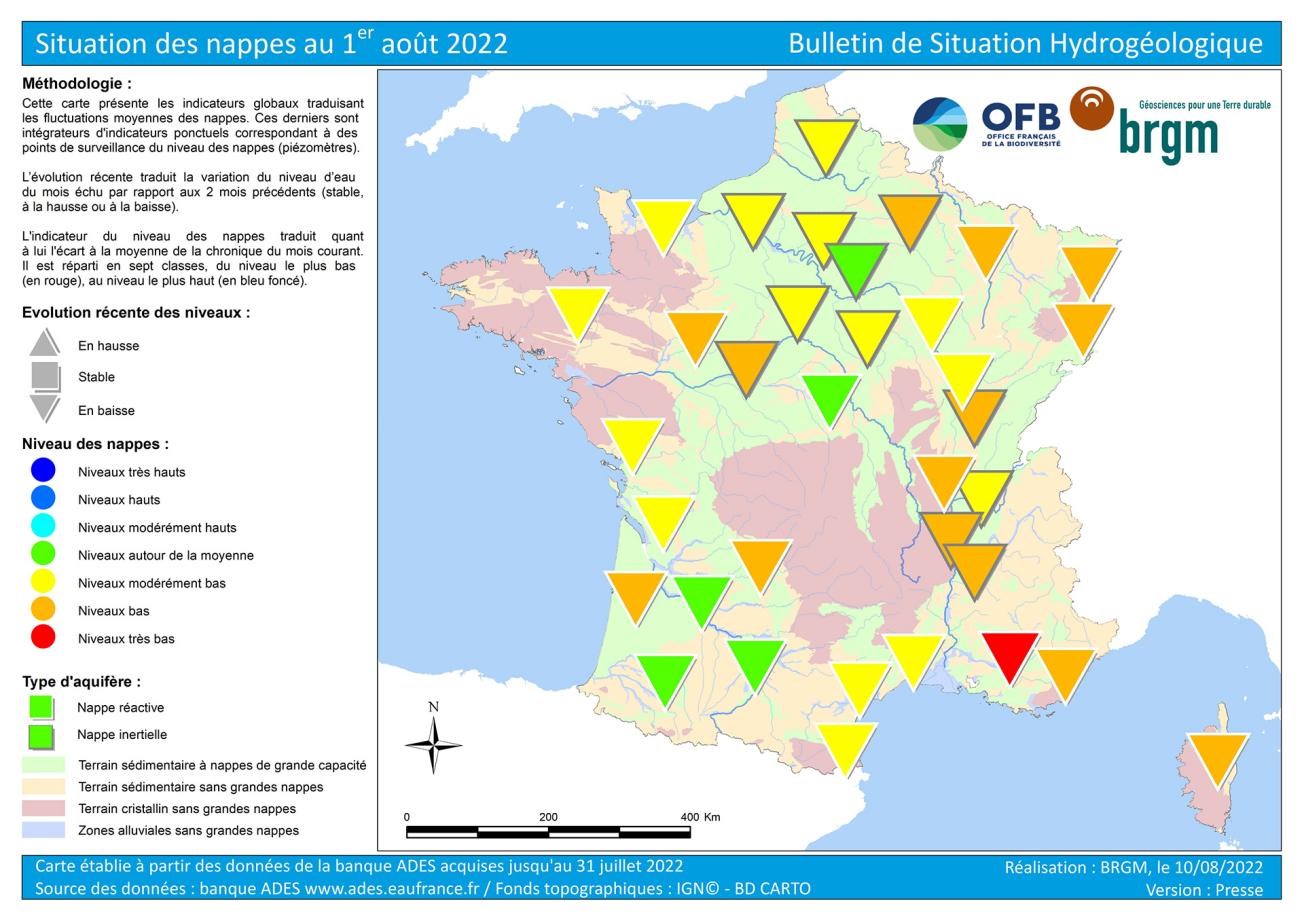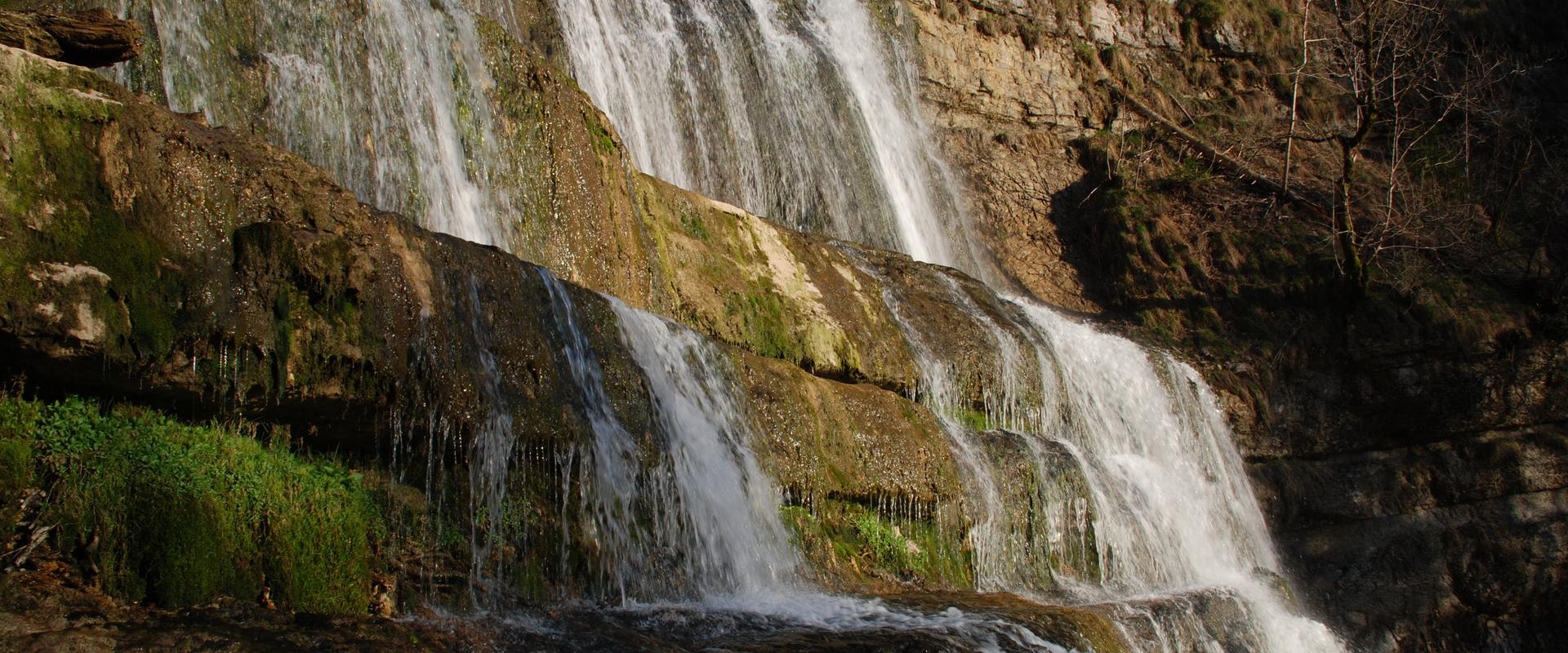
Map of water table levels in France on 1 August 2022.
© BRGM
Hydrogeological situation on 1 August 2022
In June, the depletion continued and all the aquifer levels were decreasing. This is not surprising, given the lack of rainfall. However, the intensity of the depletion is slowing down on many aquifers, probably as a result of the rainfall at the end of June and less abstraction.
The state of the aquifers remains stable and on the whole close to that of June. The inertial aquifers and those which are least in demand are the most drought resistant. However, the situation remains disquieting for many aquifers, which are showing low to very low levels. The situation is particularly worrying for areas that have very low aquifer levels, notably in the centre-west region (Poitou, Brenne, Maine, Touraine) and in the south-east (Bas-Dauphiné, Provence and Côte d'Azur).
In August, the levels of inertial aquifers were expected to continue to drop. Rainfall was not expected to infiltrate deeply. This is because extremely dry soils favour run-off over infiltration. Effective rainfall, i.e., which manages to infiltrate, is expected to moisten the soil and benefit vegetation, but is unlikely to reach the aquifers.
Concerning inertial aquifers, the situation is not expected to change much in the next few weeks, except in areas where abstractions are particularly intensive. As regards reactive aquifers, the trends and developments will depend primarily on demand for groundwater. The reduction in abstractions (due to restrictions on the use of water) should make slow down the discharge and thus avoid the aquifers deteriorating rapidly.
The situation needs to be closely monitored throughout the country and notably in all the reactive aquifers as well as in inertial aquifers, which already had low water levels, or in areas where abstraction is particularly intensive (including for drinking water).
Groundwater trends
Aquifers across the entire country experienced a winter recharge in 2021-2022 that was well below average. This recharge period ended between January and March, two to three months ahead of schedule, due to the lack of significant rainfall. Consequently, the aquifers began to empty and there was a general downward trend in levels throughout spring and the beginning of summer.
In July, the depletion continued and all the aquifer levels were decreasing. This is not surprising given the lack of rainfall during the month. Furthermore, the water which had infiltrated the ground following June rains has mainly only moistened it, to the benefit of the local vegetation. Only very rarely has it managed to infiltrate deep into the aquifers.
However, flood peaks were observed from the end of June to the beginning of July on the highly reactive Jurassic limestone aquifer of Berry, in an area extending to the south-east of Bourges. Although these increases remain momentary, they allow the piezometer levels in this sector to stabilise. The intensity of depletion has also slowed down in many of France’s aquifers. This can be explained by a small recharge episode following the effective rainfall at the end of June and by a significant reduction in water demand.
Situation in relation to July averages
In July 2022, levels were unsatisfactory and from around the monthly average to very low. This unfavourable situation is due on the one hand to the very low and short recharge in the autumn and winter of 2021-2022 and on the other to a particularly dry spring and beginning of summer.
During the spring, rainfall deficits, combined locally with high demand for groundwater, led to an often rapid deterioration in the state of the aquifers. In July, despite the fact that there was hardly any rainfall, the discharge seems to be generally less intense compared to July in previous years. The state of most of the aquifers thus seems to be deteriorating less rapidly than usual and the situation remains globally close to that of June. This can be explained by the fact that summer rainfall, which was non-existent this year in July, rarely helps recharge the water tables. The anticipation of the drought with the early issuing of orders restricting water use also made it possible to reduce the volumes abstracted and thus reduce the pressure on aquifers.
The inertia of the aquifers in the north of France and the Rhône-Saône corridor implies a strong resistance to summer droughts. The deterioration in the state of the aquifers was gradual in March-April and became more pronounced during June but then slowed in July. The situation in July is thus almost identical to that in June. Levels are low to around average for aquifers in the Paris Basin. However, the situation is often heterogeneous locally, particularly in sectors under heavy demand for abstractions. The levels are more worrying in the Rhône-Saône corridor, from moderately low to low.
Concerning the reactive aquifers, levels are satisfactory in the south-west as they are close to normal. They are of concern for the rest of the country, ranging from moderately low to well below monthly averages.
The situation was quite positive in several aquifers, which had approximately normal levels compared to those recorded in July in previous years:
- The aquifers of the Tertiary formations from the Brie to the Tardenois, which are inertial and resistant to drought, had levels close to normal;
- The situation in the Jurassic limestone aquifers of Berry improved, thanks to a recharge episode at the end of June and beginning of July to the south-east of Bourges. The levels are heterogeneous but globally comparable to normal;
- The alluvial aquifers of the Garonne (upstream and downstream) and Dordogne rivers and their main tributaries benefited from several recharge periods during the spring, thus maintaining levels close to monthly norms;
- The alluvial water tables of the Adour and Gave de Pau improved in July, a sign of a lower-than-normal discharge, and edged closer to the monthly average.
A less positive situation was observed in several aquifers, whose levels were low (or even very low, in some areas) compared to July averages:
- In the north-east, the situation is deteriorating and levels are low in the Champagne chalk aquifers, the Jurassic limestone aquifers of Lorraine and the alluvial aquifers of the Alsace plain;
- In the centre-west region, the levels of the Maine sands aquifer, the Touraine chalk aquifer and the Jurassic limestone aquifers of Poitou and Brenne are low, or even very low in some places, as a result of rainfall deficits during the winter and spring;
- In the south-west, the Aquitaine plio-quaternary aquifer continues to diminish rapidly and the situation is deteriorating, resulting in low levels;
- In the centre-east, the levels of the inertial plio-quaternary gravel aquifers of Burgundy-Franche-Comté, the alluvial aquifers and the river-glacier corridors of the middle Rhône and the Miocene molasse of the Bas-Dauphiné are low to very low, the result of several successive deficient recharges and of a progressive degradation since the beginning of the year;
- In the south-east, the levels in the alluvial aquifers and in the complex formations of Provence and the Côte d'Azur are still of concern. The levels remain low to very low, due to insufficient recharges in 2020-2021 and 2021-2022, as well as a fairly severe low-water period in the summer of 2021. Only the sectors subject to excess gravity irrigation have been spared (middle and lower Durance);
- Corsica’s coastal alluvial aquifer levels are low.
Forecasts
The seasonal forecasts of Météo-France announce "hotter than normal conditions" for the next quarter. A drier-than-normal scenario is likely in the north-eastern quarter of the country, and no particular scenario has emerged for other parts of the country. However, episodes of heavy rainfall could occur from time to time.
The next rainfall episodes should initially moisten the soil and benefit the vegetation. In addition, the current, extremely dry ground, favours runoff. The effective rainfall is therefore not expected to infiltrate deeply into the water table before the arrival of significant rainfall events. The depletion of aquifers is thus expected to continue across the whole country.
For the inertial aquifers, levels are unlikely to rise before October-November and no improvement is expected before the autumn. The situation is expected to persist or gradually deteriorate, more or less slowly, depending on the volumes of groundwater abstracted. The situation could become crucial in the inertial aquifers of the Rhône-Saône corridor and in the aquifers in the south and east of the Paris Basin.
As regards reactive aquifers, the trends and developments will depend primarily on effective local rainfall and the demand for water. If there is insufficient rainfall, levels should remain low and the situation will continue to deteriorate. Most reactive water tables will then certainly reach low to very low levels by September-October. Only the south-west of France is likely to be spared, with levels still satisfactory in July. Significant rainfall events will be required to cause recharging episodes. In August, intermittent recharges could help maintain aquifer levels and possibly even lead to an increase in levels from time to time. In this case, the situation might improve in certain areas, although above-average levels would still not be reached in aquifers that have extremely low to very low levels.
In the short term, in the absence of sufficient effective rainfall, the only solution for preserving the state of the aquifers and maintaining continuity between groundwater and surface water is to limit water abstraction. Water restriction orders help to relieve the pressure on water resources. Slowing down the discharge avoids rapid deterioration in the state of the aquifers and postpones the occurrence of severe low water in rivers while waiting for effective rainfall. The situation needs to be closely monitored throughout the country and notably in all the reactive aquifers as well as in inertial aquifers, which already had low water levels, or in areas where abstraction is particularly intensive (including for drinking water).
Hydrological Status Report
The national hydrological status report consists of a set of maps with corresponding comments that show the monthly evolution of water resources. It describes the quantitative situation of aquatic environments (effective rainfall, river discharge, groundwater table levels, reservoir-dam filling status) and provides summary information on Prefectoral Orders issued to limit water use during the low-water period.
Press contact








